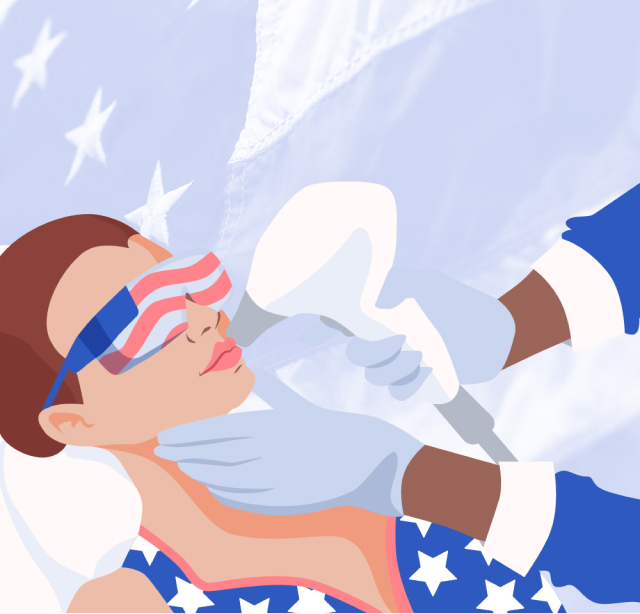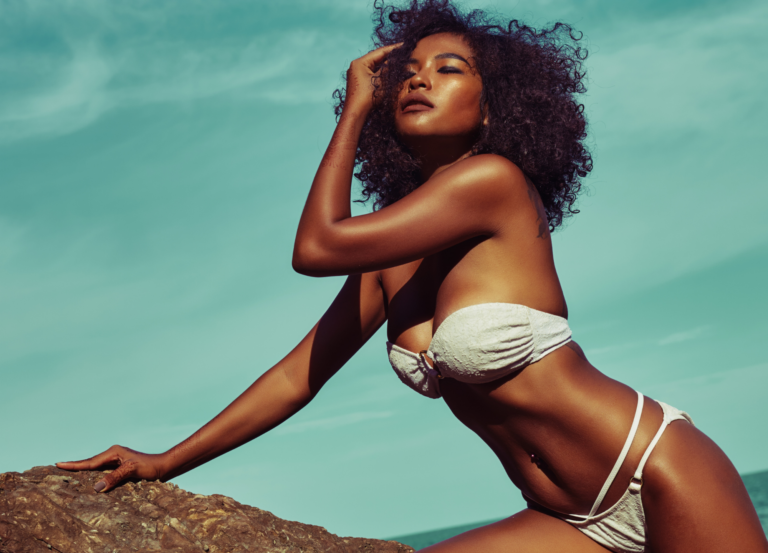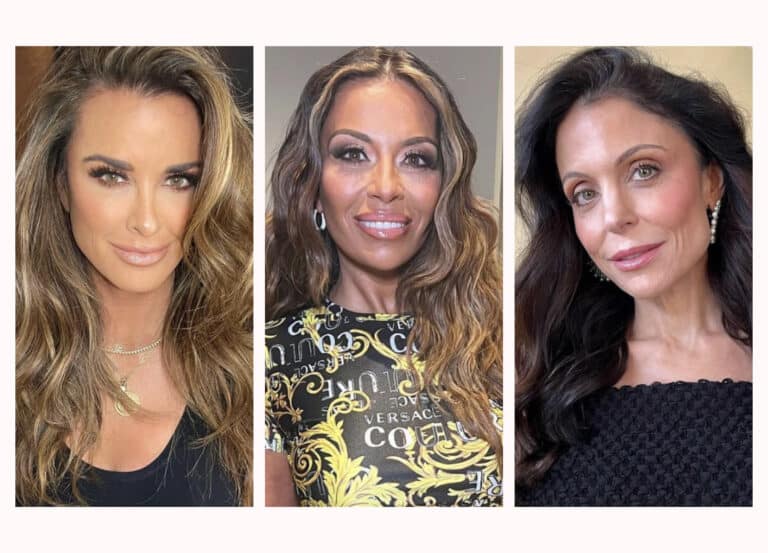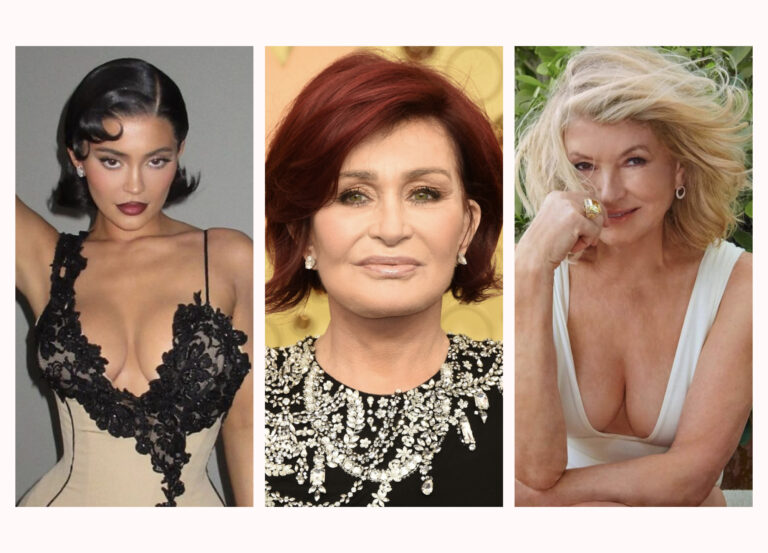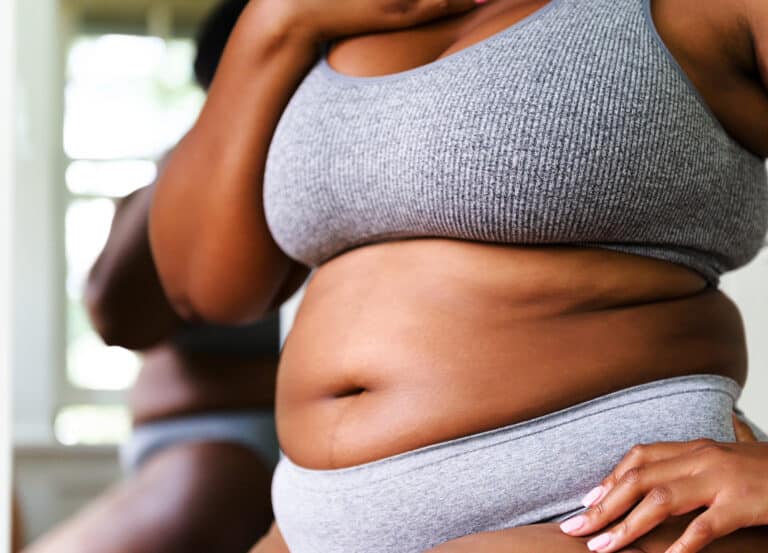
The RealSelf Culture Report
How Americans Feel About Plastic Surgery in 2023
by RealSelf, in collaboration with YouGov
Written by Alix Tunell
Nearly 1 in 4 people in the United States (24%) have had at least one cosmetic procedure, and 12% have had two or more. Plastic surgery has become an undeniable part of the zeitgeist, and the number of aesthetic procedures being performed worldwide keeps climbing.
The RealSelf Culture Report is an independent survey conducted by YouGov that captures how Americans view plastic surgery now—looking at the ways celebrities influence our aesthetic desires, how our political leanings play into our judgments, the pressure some feel to look younger at work, and the milestones that motivate us to alter our appearance.
For the 486 out of 2,002 survey respondents who said they’ve had a cosmetic procedure, these were the most common answers:
- Cosmetic dental work (46%)
- Laser treatment (18%)
- Weight loss surgery (11%)
- Breast surgery (9%)
People who had a procedure were most likely to share the news with friends (45%), followed by spouses or partners (37%), parents (23%), children (15%), and coworkers (14%).
People may be more willing to have conversations about their aesthetic choices due to a sense of growing acceptance.
- 18% of respondents said attitudes toward plastic surgery among their social group have become more positive over the past three years.
- This uptick in positivity is particularly notable when comparing those who are ages 18–29 vs. 45–64 (27% vs. 13%) and Black and Hispanic/Latino populations vs. white (23% vs. 16%).
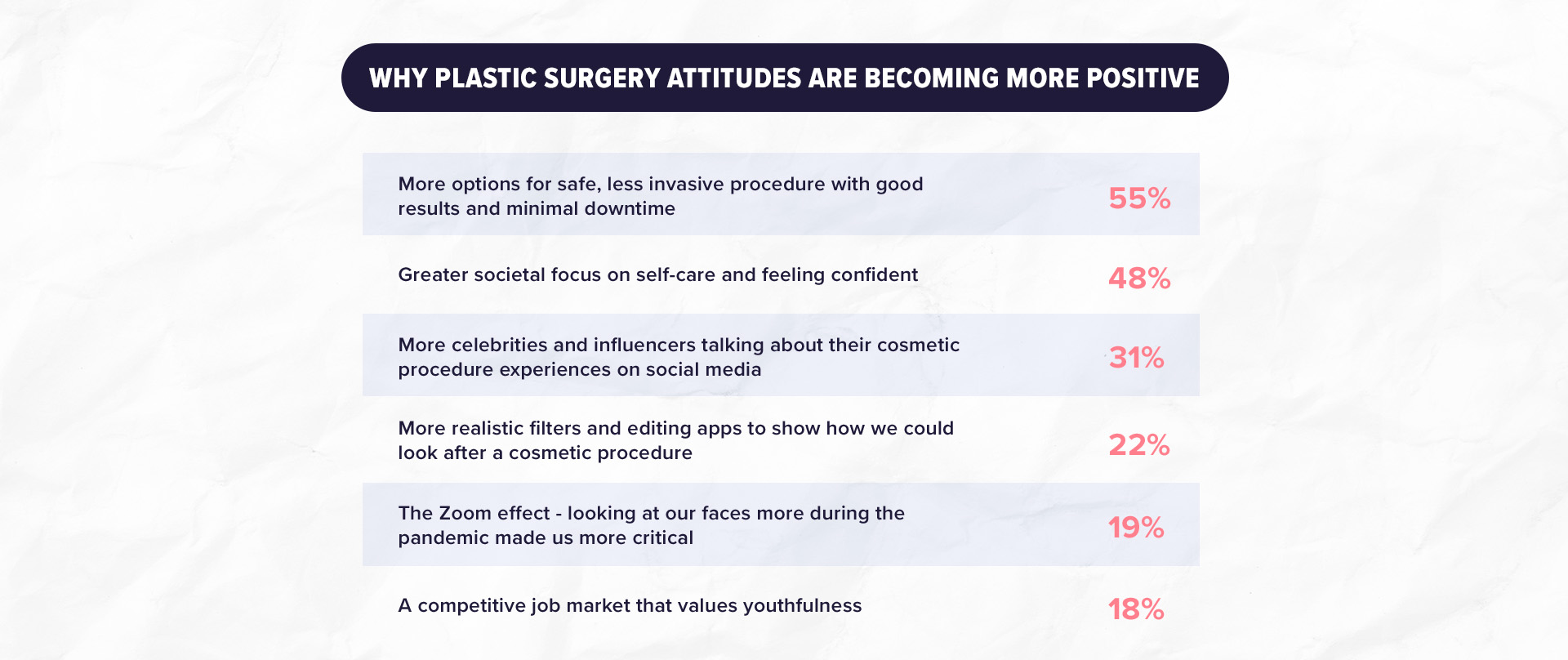
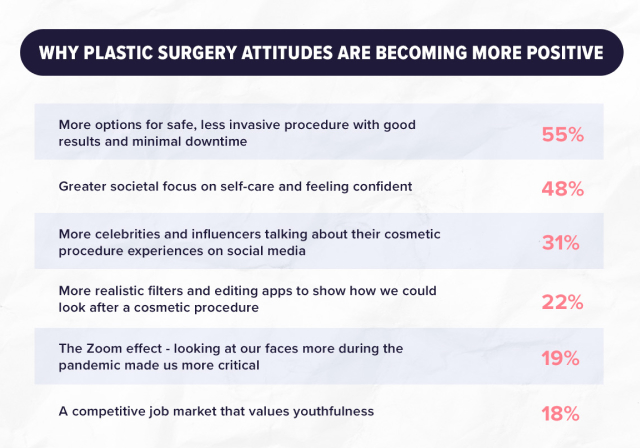
Surprisingly, it’s not “the Zoom effect” or the proliferation of face-altering filters on social media or celebrities being more candid about their nips, tucks, and tweaks that’s driving this trend. Both men (51%) and women (57%) attribute these increasingly positive attitudes to having more procedure options that are safe, are minimally invasive, and require less downtime; 48% of men and women credit a greater societal focus on self-care and confidence.
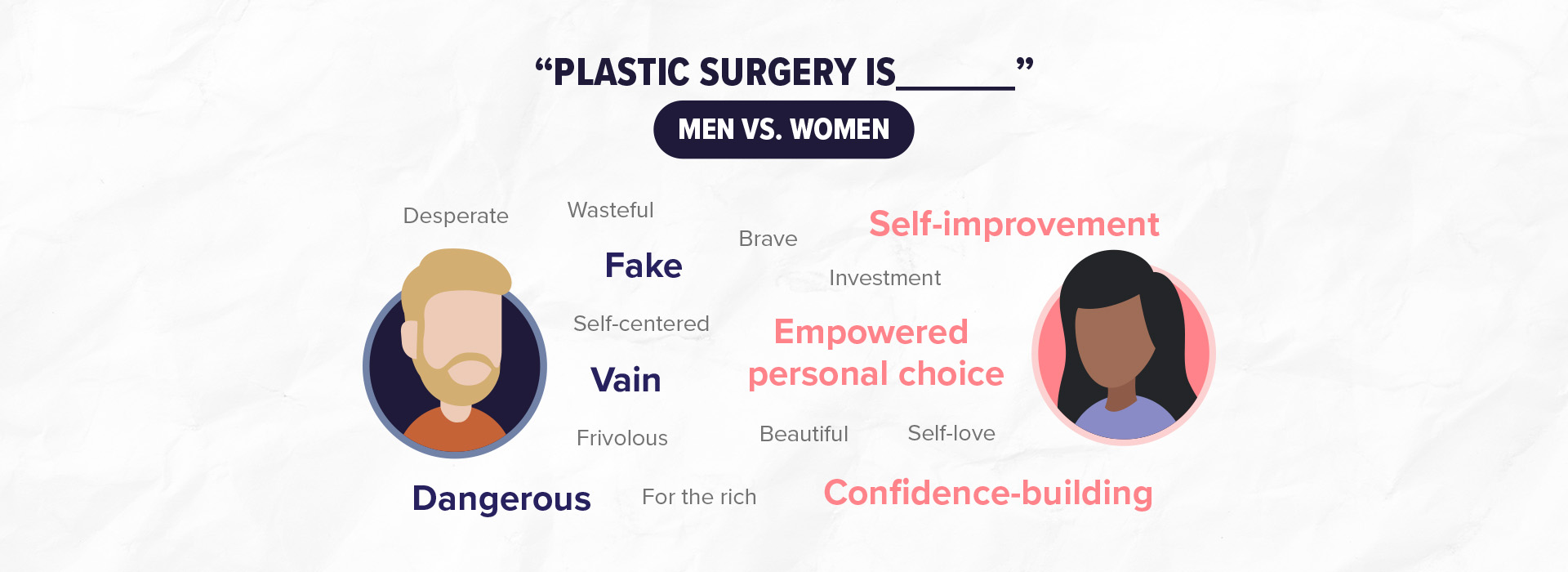
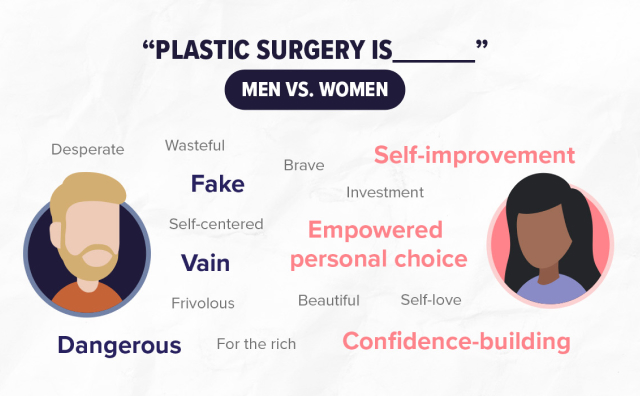
But though the stigma around cosmetic work has decreased, it hasn’t disappeared—just ask the guys. Male respondents expressed strongly negative feelings toward plastic surgery and chose fake (35%), vain (29%), dangerous and financially wasteful (27%) as top attributes, whereas women said plastic surgery is a form of self-improvement (32%), an empowered personal choice (31%), and a way to build confidence (30%).
Read on for more of what we learned about plastic surgery as it relates to pop culture, politics, money, and our personal lives, from our national survey of 2,002 Americans from all regions and walks of life.

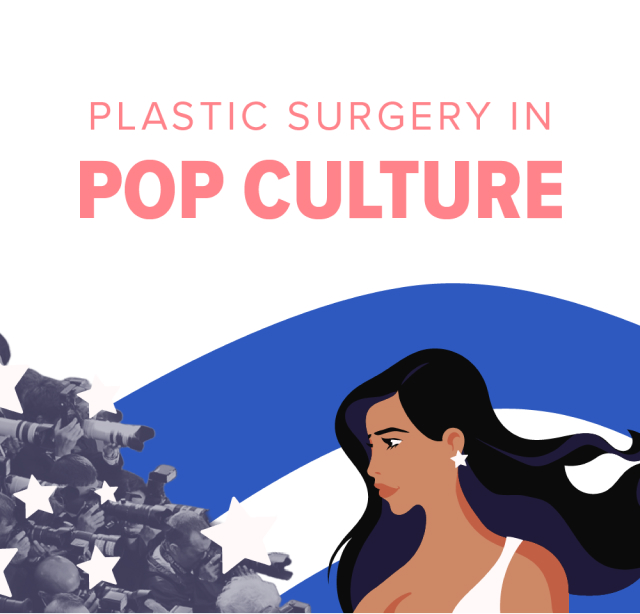 Expand
Expand
How Celebrities and Social Media Influence Us
While plenty of celebrities still swear that water, sleep, and olive oil are the secrets to their taut necks and jawlines at fiftysomething, we’ve entered an era of greater transparency around cosmetic treatments than ever before. Entire storylines have been built around Real Housewives’ nose jobs, stars are showing their breast implant removal scars on Instagram, and even Kylie Jenner is admitting it’s time she and her sisters have a “bigger conversation about the beauty standards we’re setting.”
It’s not surprising, then, that 44% of Gen Zers say they’ve learned about cosmetic procedures via social media (compared to 30% of Millennials, 14% of Gen Xers, and just 8% of Boomers).
How does hearing about and seeing increasingly more cosmetic work on our screens affect us?
When it’s obvious that a celebrity has altered their appearance with plastic surgery:
- 41% of women said they feel sad about the pressure celebrities feel to stay relevant, and 33% said it makes them want to avoid plastic surgery.
- Men were less likely to empathize, with 34% answering that it seems desperate and 30% saying it makes them think the celebrity is vain.
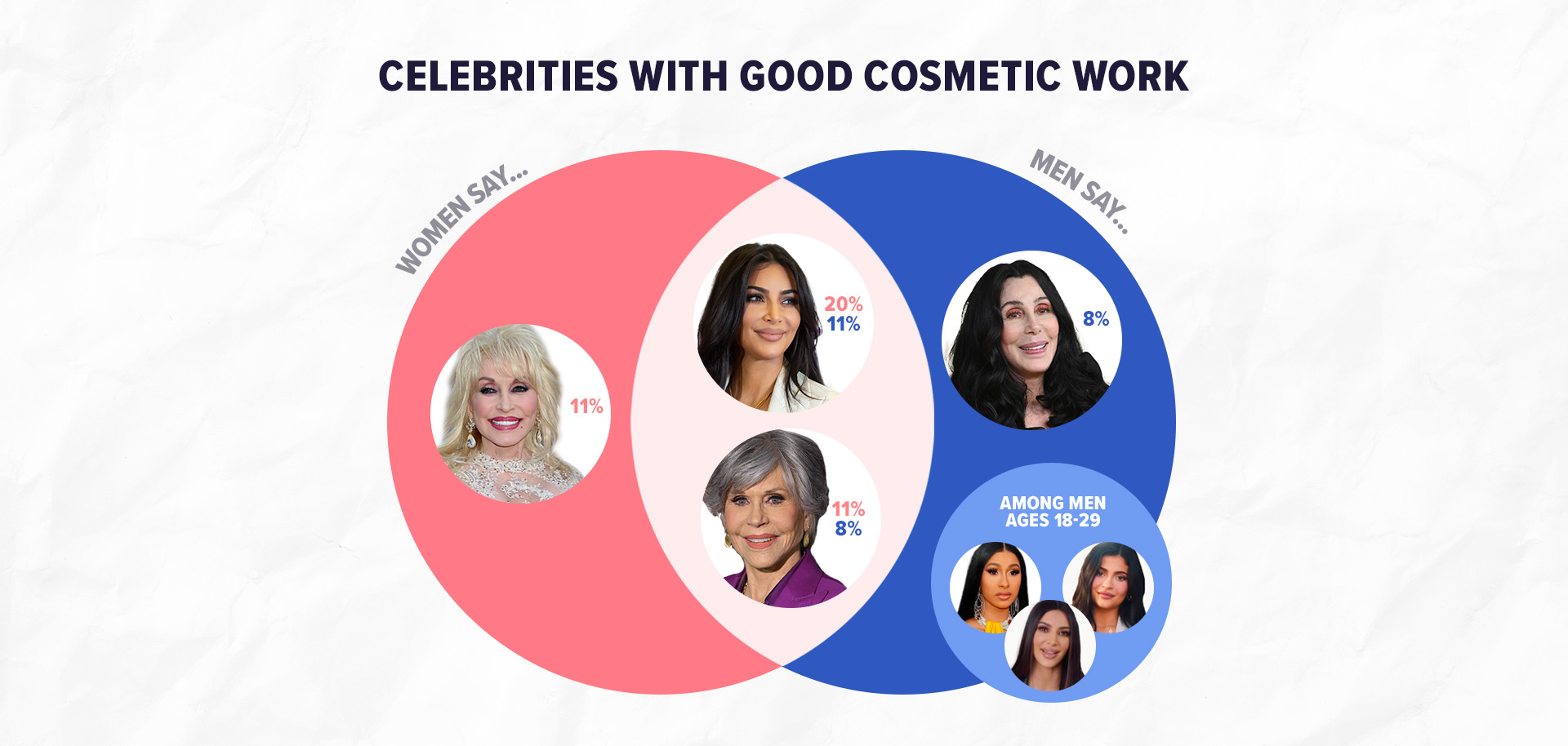
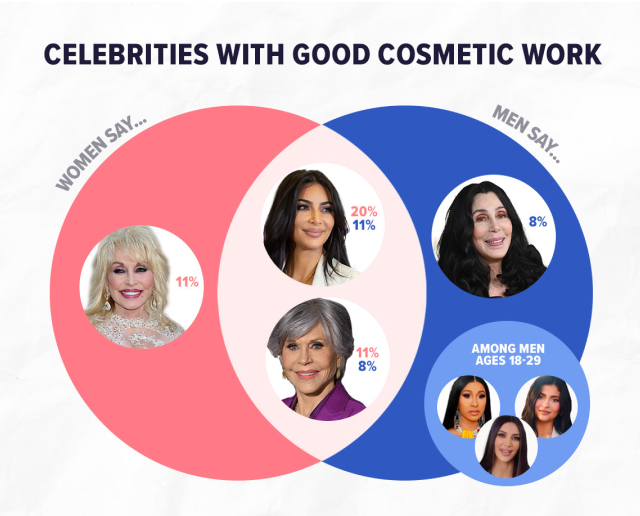
Among respondents who named a celebrity they think has had good cosmetic work:
- Both men and women cited Kim Kardashian and Jane Fonda most often.
- More women chose Dolly Parton; more men chose Cher.
- In addition to Kim Kardashian, Gen Z men picked Cardi B and Kylie Jenner.
As for which celebrities have had bad cosmetic work? Madonna (15%); Michael Jackson (8%); Joan Rivers (5%); and Kim Kardashian, Kenny Rogers, and Meg Ryan (4%) topped the list among respondents who named a celebrity.
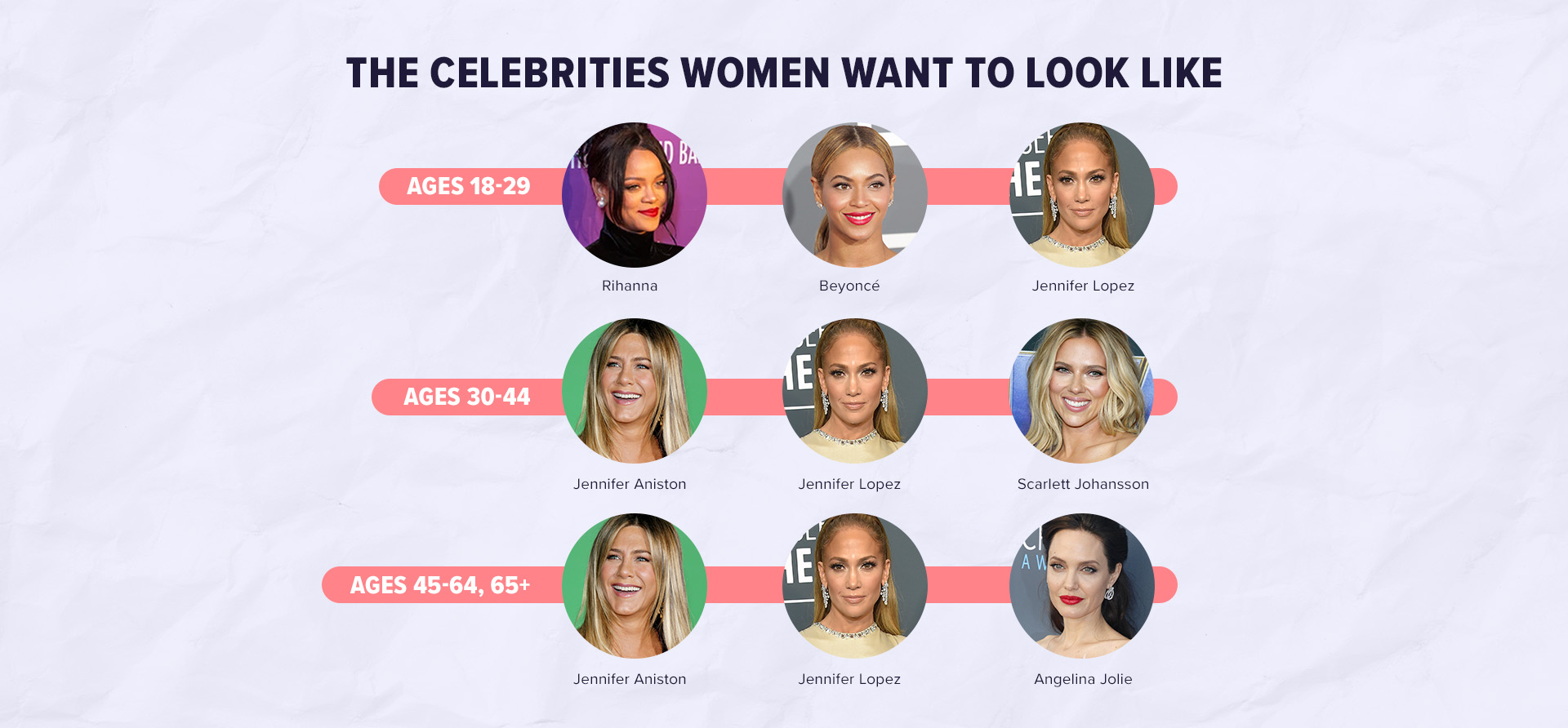
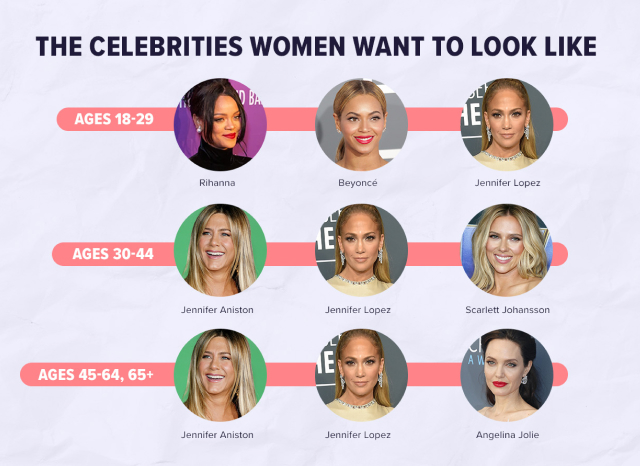
64% of Gen Zers and 62% of Millennials said they would like to have a female celebrity’s feature. In stark contrast, 68% of Boomers do not want any female celebrity’s feature.
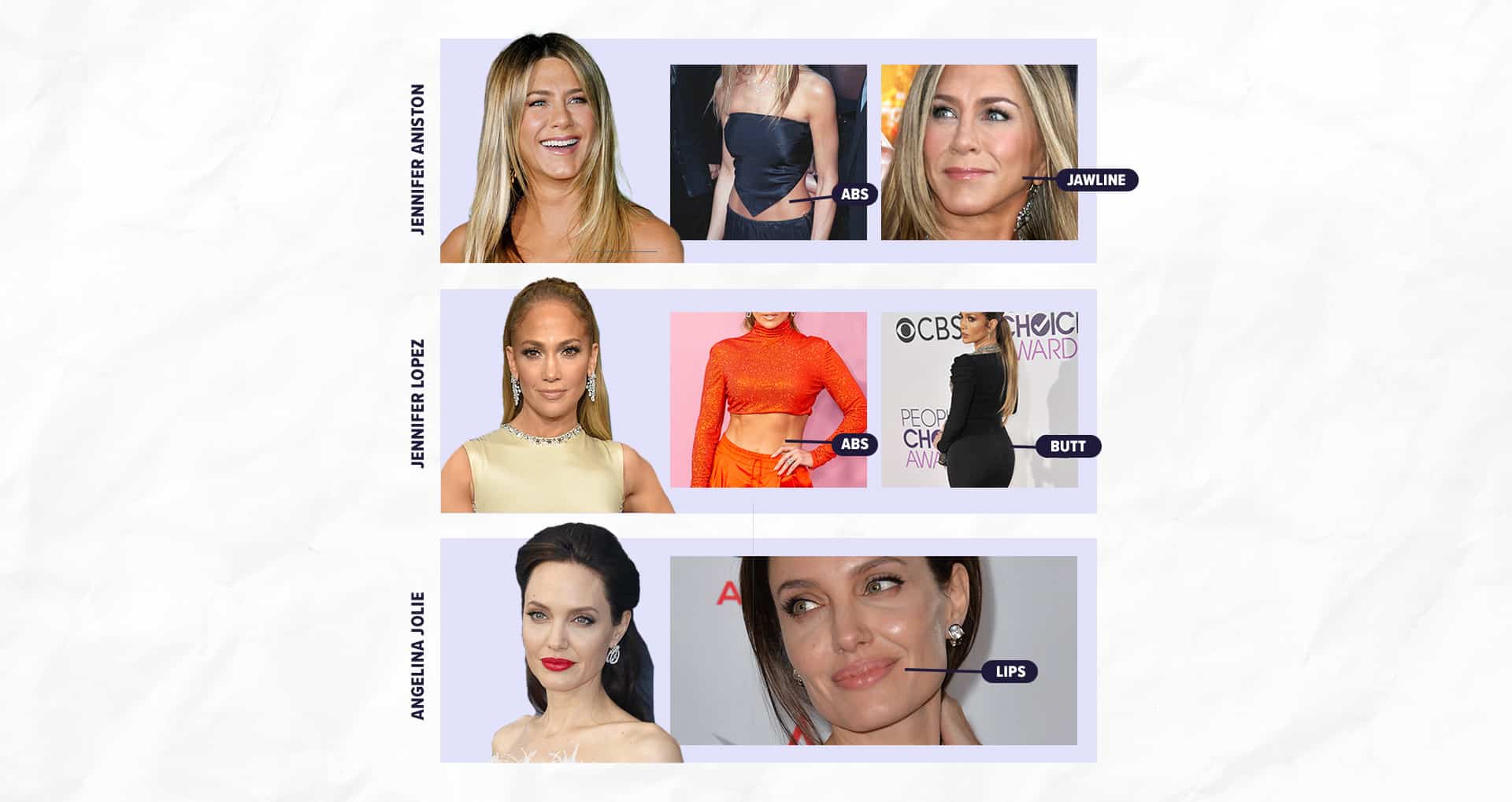
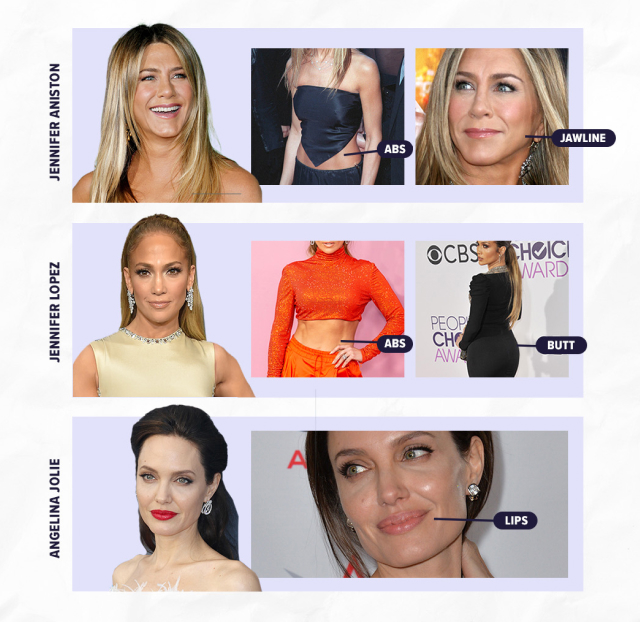
These are the most in-demand features among women of all age groups who chose Jennifer Aniston, Jennifer Lopez, or Angelina Jolie.


These are the most in-demand features among men of all groups who chose Brad Pitt, George Clooney, and Cristiano Ronaldo.

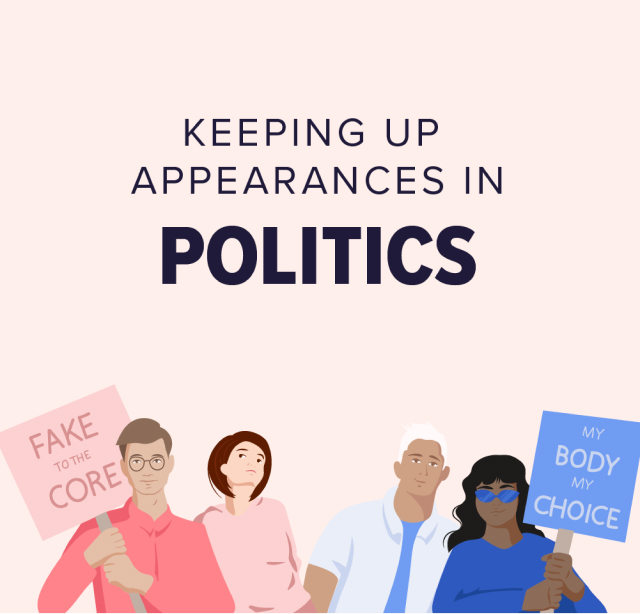 Expand
Expand
What Our Voting Habits Say About Our Attitudes Toward Plastic Surgery (and Vice Versa)
The most quintessentially American political parable with an aesthetics lesson is that of the first nationally televised presidential debate. As it’s taught in U.S. history classes, Richard Nixon showed up looking pale and sickly after a recent hospitalization and refused makeup for his five-o’clock shadow. John F. Kennedy accepted makeup and went on-screen with an enviable tan and bright smile, winning over the American public and, ultimately, taking the presidency. There’s no real evidence to support the claim that JFK won because of his appearance rather than his competence, but we take it at face value because, well, of course looks matter.
But where do we draw the line, when it comes to what our politicians do in order to look good?
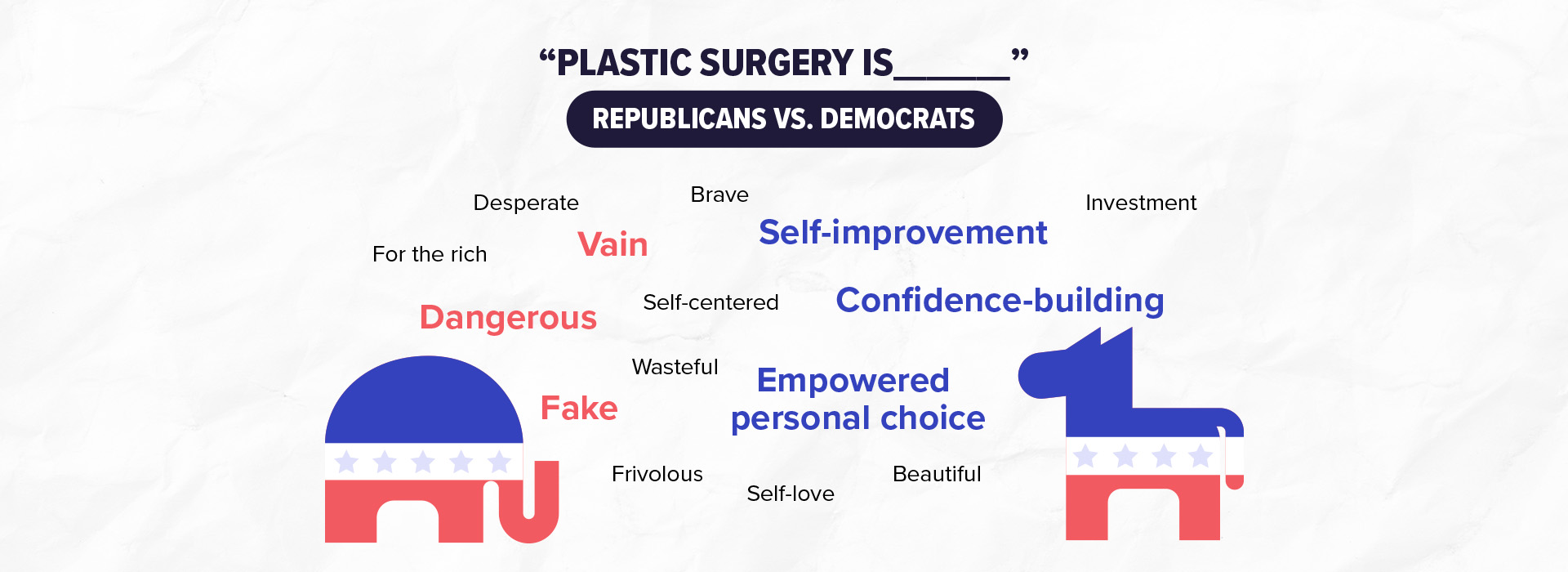
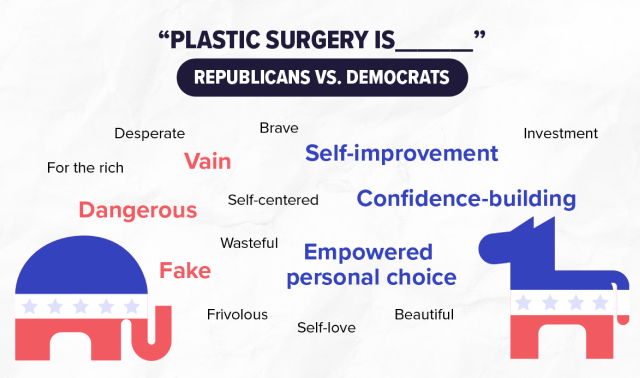
When asked to describe “what plastic surgery is” from a list of positive and negative attributes, the top three selections among people who identify as Republican were fake (39%), dangerous (32%), and vain (31%).
Among those who identify as Democrat, the top three were a form of self-improvement (33%), an empowered personal choice (30%), and a way to build confidence (30%). Talk about a political divide.
Democrats were voted more likely to get plastic surgery than Republicans by people* of every political persuasion and age group.
*Among those who chose a specific party
29% of Democrats have had a cosmetic procedure versus 22% of Republicans and 22% of Independents. 16% of Democrats have gotten 2 or more procedures compared to 9% of Republican voters.
Both political parties agreed that the number one reason Democrats are more likely to get cosmetic work done is that they tend to value appearance more. But each group took a dig at the opposing party with their second-choice reasons: Republicans said it’s because Democrats are less attractive, while Democrats said it’s because they make more money and/or have more disposable income.
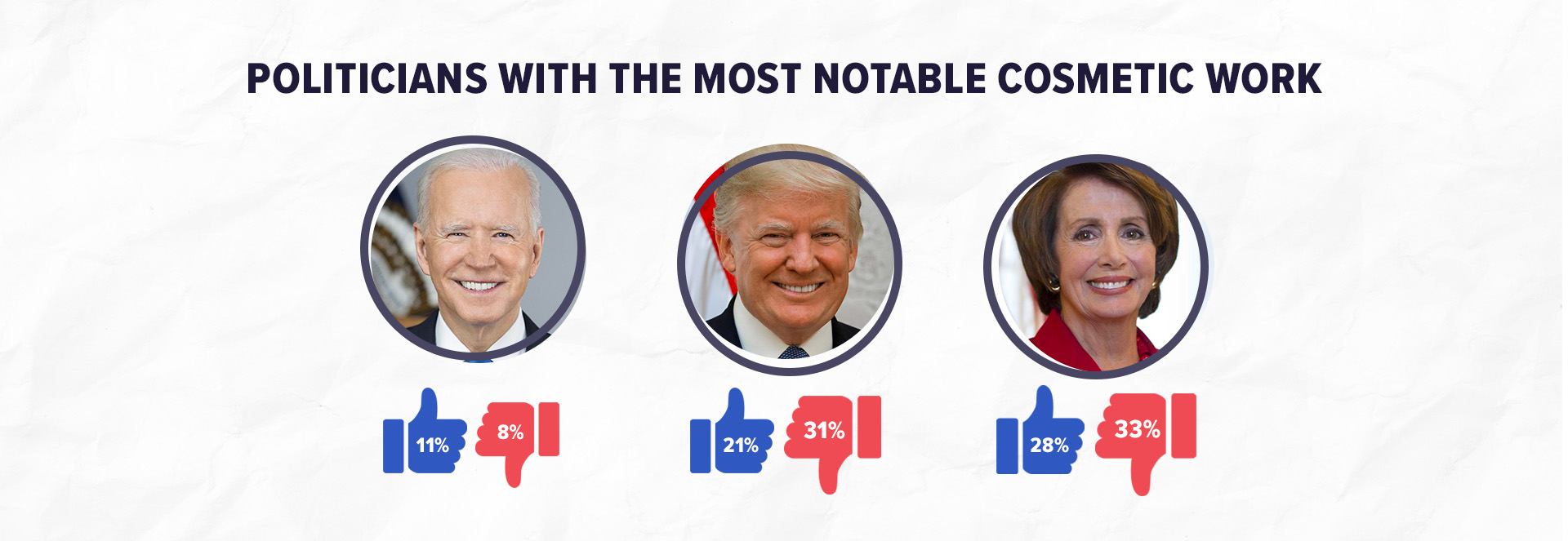
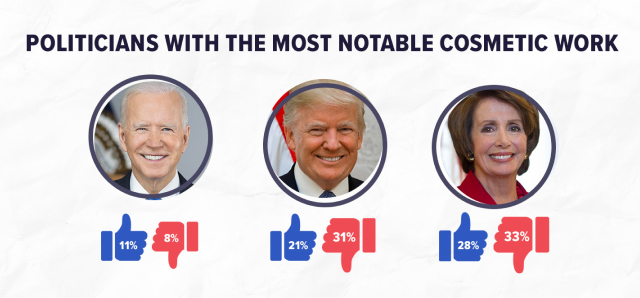
Among survey respondents who named a politician they think has had cosmetic work, 19% cited one with bad cosmetic work, while just 8% mentioned one with good cosmetic work. Nancy Pelosi, Donald Trump, and Joe Biden were the top three mentioned. The thumbs-up icon in the image above represents the percentage of respondents who consider their cosmetic work to be good, while the thumbs-down icon represents the percentage who consider their cosmetic work to be bad.
20% of Republicans say it’s inappropriate for any politicians, male or female, to get plastic surgery. Only 9% of Democrats think it’s inappropriate.

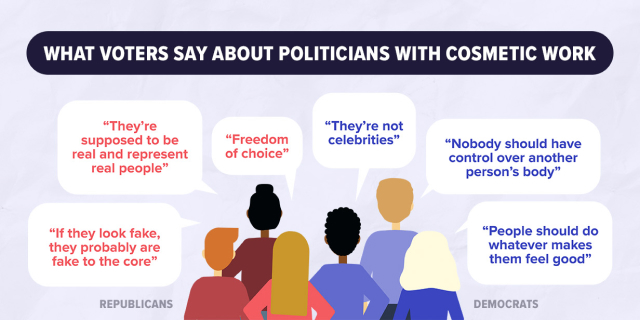
Despite the strong personal feelings of some in their party, the majority of Democrats (72%) and Republicans (69%) say they’re not more or less likely to vote for a candidate who has had a cosmetic procedure. As one blue voter put it, “The way they look shouldn’t influence their politics or how their constituents view their politics.”

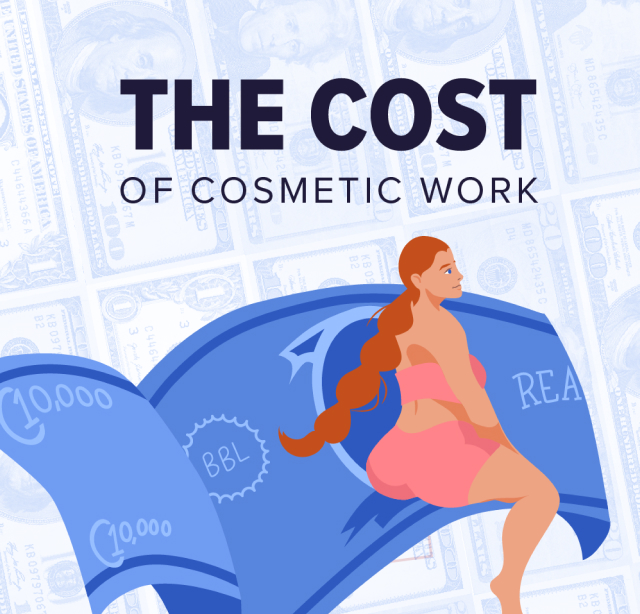 Expand
Expand
How Workplace Pressure, Age, and Income Affect Aesthetic Spending Habits
You can’t talk about cosmetic procedures without mentioning money. Of people who have considered a treatment or surgery but have not had one, 60% say it’s because they aren’t financially ready yet. Lineless foreheads and gleaming teeth are indeed status symbols in our culture, where “the new 50” keeps getting younger and facelift prices can make Birkin bags look like a downright bargain. So we wanted to know: How do Americans really feel about plastic surgery spending?
40% of people making $150K or more have had a cosmetic treatment.
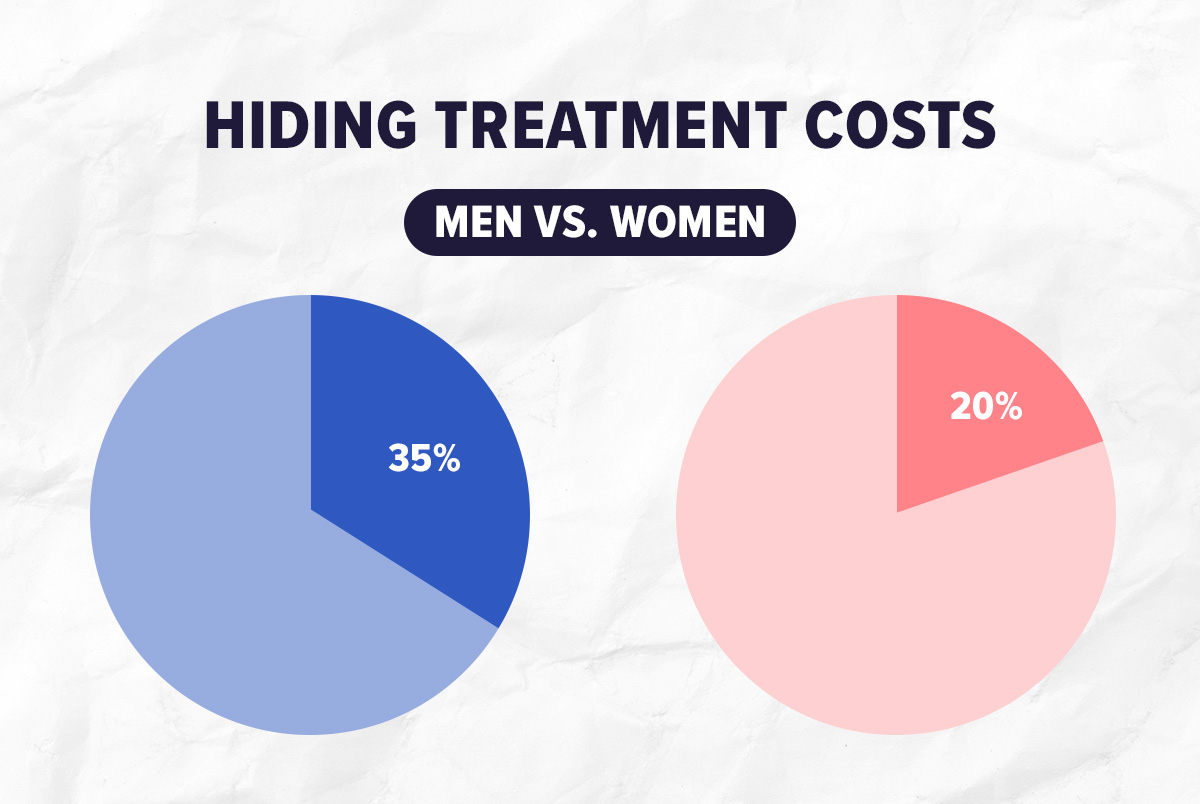
35% of men say they have hidden or would hide their cosmetic-treatment spending from a partner, making them 15% more likely to hide it than women.
Younger people are more likely to hide costs too: 44% of Gen Zers say they have hidden or would hide their spending from a partner vs. 22% of Gen Xers. And those in the highest income bracket, making $150K or more, are the most likely to have hidden or hide costs.
How much would you spend to get the look you want?
26% of 30- to 44-year-olds would spend anywhere from $10K to $100K to have their dream feature.
☝️But 65% of people ages 45–64 and 74% of people 65+ wouldn’t spend any amount on plastic surgery.
Layoffs are up nearly fivefold in 2023 compared to 2022, with job cuts hitting the tech industry the hardest, followed by finance, then healthcare and retail. In a competitive job market and the new age of AI, staying relevant is top of mind for many: 16% of people say they feel pressure to look younger in the workforce.
The top fields driving feelings of pressure among workers:
- Marketing/Advertising/Communications: 29%
- Tech/Science: 28%
- Construction: 23%
- Entertainment, Hospitality, Finance/Insurance: 21%
The income bracket most likely to feel the most workplace pressure to look younger: people making $150K or more (23%).
Younger generations also feel the most pressure to look younger at work:
- Millennials (27%)
- Gen Z (27%)
- Gen X (14%)
- Boomers (4%)

 Expand
Expand
Motherhood, Milestones, and the Generational Divide
Life comes at us fast—one day, you’re young and full of collagen; the next, you’ve got gray hairs growing in strange places. For so many who get cosmetic procedures, the desire isn’t to look like a different person; it’s simply to get back what was lost—in an accident, in the natural aging process, in bringing a new life into the world.

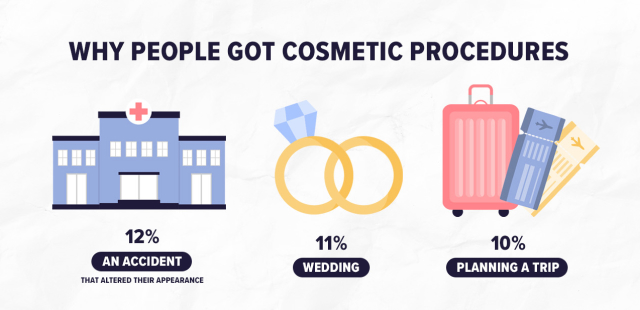
We asked: Was your decision to get a cosmetic procedure inspired by a major life event? Among those who answered yes:
- 12% experienced an accident that altered their appearance
- 11% had an upcoming wedding
- 10% were planning a trip
The top procedures for people who had been in an accident and people who were planning a trip were cosmetic dental work, hair restoration, and weight loss surgery. For those planning a wedding, cosmetic dentistry, laser treatments and chemical peels were the most popular choices.
Motherhood is a life-altering milestone that, for many, requires sacrificing the body you knew. Pregnancy and childbirth can leave lasting changes, and mommy makeovers can help women to feel like their pre-baby selves again: 18% of people ages 18–29 said they discussed mommy makeover procedures with their partner prior to giving birth and that their partner was supportive if they chose surgery in the future, while only 4% of people ages 45–64 said they discussed the procedures and their partner was supportive.
Womens’ biggest post-birth body surprises:
- For all: how difficult it was to lose weight (32%)
- Among 18–29: appearance of breasts (33%) and hair loss (28%)
- Among 30–44: abdominal skin laxity (37%) and stretch marks (36%)
- Among 45–64: how difficult it was to lose weight (31%)
- Among 65+: nothing was a surprise (33%)
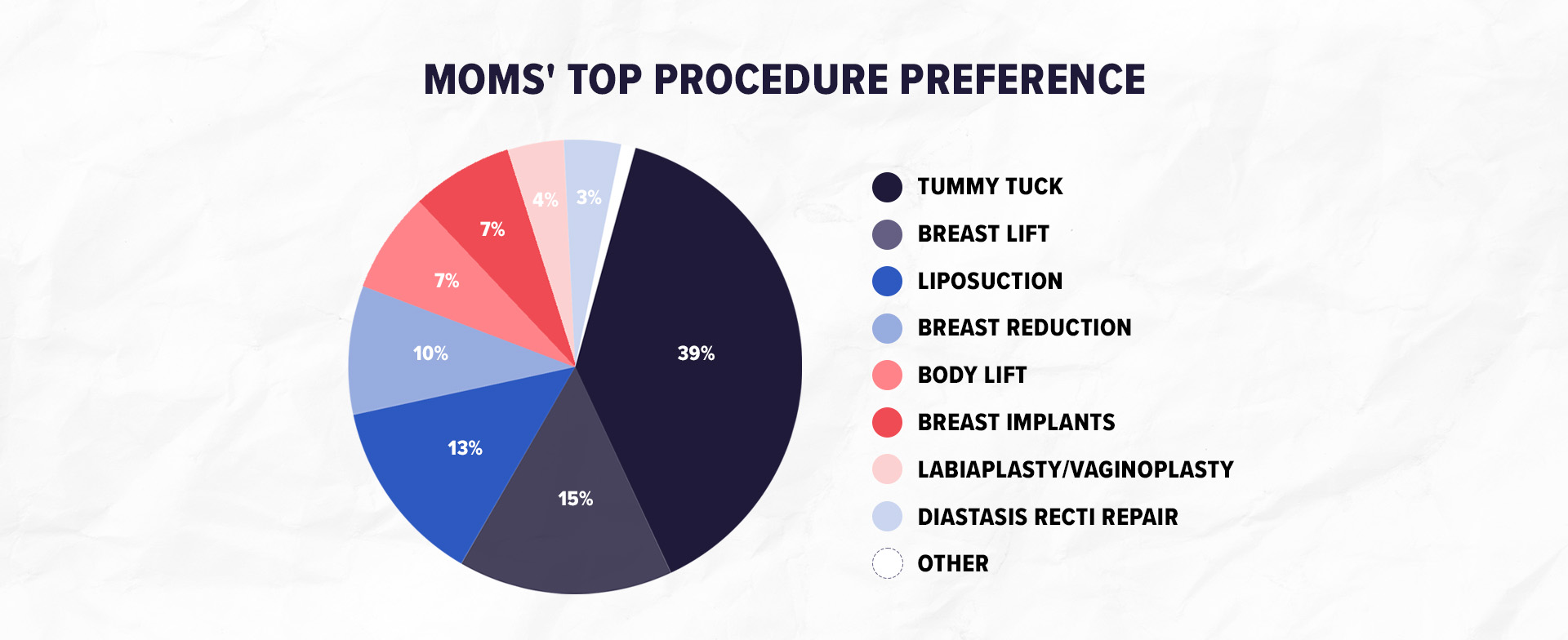
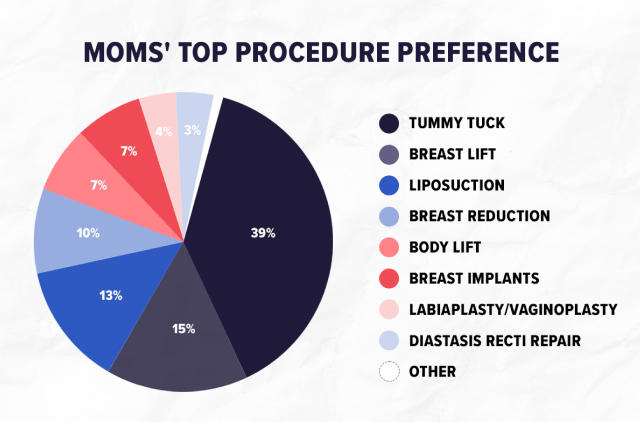
Of women who said they would be interested in a cosmetic surgery to address their postpartum body concerns, 39% picked tummy tuck surgery as their top choice, while 32% of moms chose some form of breast surgery—a breast lift, breast implants, or a breast reduction—and 13% chose liposuction. It makes sense, given that a tummy tuck, breast surgery, and lipo make up the most common procedure combinations in a mommy makeover.
Report Methodology
The 2023 RealSelf Culture Report was designed to explore and understand Americans’ attitudes toward plastic surgery and their perceptions of others who undergo cosmetic procedures. Online survey recruitment was conducted independently of RealSelf via YouGov, an international research data and analytics group. The sample size of 2,002 respondents was nationally representative of the general population (18+). Data was collected April 3–12, 2023.








